Context
 Since Nawaz Sharif came to power, he has consistently talked about improving ties with India and Pakistan’s other neighbors. However, the otherwise calm situation on the LoC is increasingly getting tense. The good intentions do not seem to be aligned with the ground reality.
Since Nawaz Sharif came to power, he has consistently talked about improving ties with India and Pakistan’s other neighbors. However, the otherwise calm situation on the LoC is increasingly getting tense. The good intentions do not seem to be aligned with the ground reality.
Allegedly, Pakistani troops crossed the LoC and attacked Indian Chakanda Bagh check post in the Poonch sector on August 6 and as a result six Indian soldiers were reportedly killed. A similar incident had taken place in January, in which an Indian soldier was decapitated. Pakistan’s military promptly denied carrying out any such assaults. According to reports, in both instances the intruders were wearing Pakistan army’s uniform. The reaction from the Indian political and military leaders to the latest attack has evolved to become quite harsh, with casualties being reported daily on Pakistan’s side of LoC.
The similarities between the two cases have raised the possibility of jihadi elements being involved. Since the latest ambush, India has alleged that Pakistan’s Special Forces have carried out these attacks in conjunction with extremist elements, forming what it calls the Border Action Team (BAT).
On the other hand, Indian Consulate in Jalalabad also came under attack on August 3, which Indian authorities believe was instigated by Pakistan. The occurrence caused nine causalities, mostly ordinary civilians and security guards protecting the outpost. It is difficult to understand why Pakistan would want to harm relations with India at this juncture. The economic and security perils of the nation dictate otherwise. The question though remains: who was responsible?
Analysis
Jihadi Groups
It could be the militant jihadi groups, trying to circumvent the resumption of Pakistan-India talks, aimed at normalizing relations. The dialogue has remained limited since the 2008 Mumbai incident. Equally, it could be the hardliners and nationalist forces on the Indian or Pakistan sides that do not want increased trade between the two nations. It could also be a third hand that benefits from the extension of status quo and tensions in the region. It should be noted that continued wrangling between India and Pakistan benefits the global powers strategically.
Perceived from the Indian angle, a suspicion may linger about the possible connection between Chinese intrusions in the Ladakh region and the LoC attacks. Despite the jingoism and media euphoria displayed at the time of Chinese intrusions in the Ladakh region, India has resorted to diplomatic channels to calm things down. With Pakistan, India cannot afford to appear weak, as it did in the case of China. It should be added that in the aftermath of the Ladakh incidents there is increase traffic of senior US officials to India, including recently US VP Joe Biden. PM Manmohan Singh is also slated to meet President Obama on his upcoming trip to US in September.
Post US Withdrawal Afghanistan
Moreover, both Afghanistan and India share apprehension about how the state of affairs may evolve in the post US Afghan withdrawal regional scenario. India has calculated that if the jihadi network remains intact after the withdrawal, Kashmir may become active once more. On the other hand, Afghanistan fears that Afghan Taliban, with the help of Pakistan based comrades, may try to dominate once more. In essence, it may be a return to the pre 9/11 conditions, which did not bode well for both nations.
Through these border attacks, and strikes against Indian interests in Afghanistan, there may be an attempt to revert the American focus on these jihadi groups. With the US trying the speed up the Afghan reconciliation and withdrawal, India fears US has once more gone lenient on these extremist groups. India may also be looking closely at what is transpiring in Syria.
The Arab Factor in Indo-Pak Politics
The Arab Spring and the War on Terror has produced a new alignment of interests in the Middle East where former adversaries have now become undeclared allies.
The emerging configuration includes Gulf States, Israel, Turkey and the West, aligned on the one side. The other loose arrangement constitutes, China, Russia, Iran, and Syria. It is hard to miss the Shia-Sunni divide in the unfolding alignment of interests. The other undercurrent to keep in perspective is the state versus non-state actors. While the Sunni state actors are aligned with Israel and the West, the Sunni non-state actors are not. This divergence is likely to produce the most volatile turbulence in the region and beyond.
While US appears to be mostly backing Sunni states, Russia and China maintain ties on both sides of the isle. Pakistan shares this strategy with Russia and China, and does not unnecessarily want to make an enemy out of Iran. However, due to its strategic ties with Israel and the US, and fear of China, establishing this balance has become quite difficult for India.
As the relations tense up between Russia and the US on the one hand, and China and US, on the other, militant and religious proxies could once again become important. Some of this is already at display in Syria and to which Russia has repeatedly pointed out. Other than AQ, US is becoming more accommodating to nationalist and religious militant groups, as evident in the case of Afghan Taliban as well. If this outlook continues, it is highly threatening for not only the monarchs of the Gulf, but also for India and Afghanistan.
The unfolding situation of Syria, and the evolving American position, may push Gulf States and India closer, at the cost of Pakistan. This first became apparent in 2012 when Saudis handed one of the prime suspects of 2008 Mumbai attack, LeT affiliated Sayed Zabiuddin Ansari, to India.
So while Nawaz Sharif and Manmohan Singh wish for good ties, much inertia exists to such a prospect on both sides, and beyond. In Egypt, tables turned on the Islamists with the decisive role of its military. In the coming days and months, the ambiguity about the connection between the state and non-state actors, is likely to be tested in South Asia.



